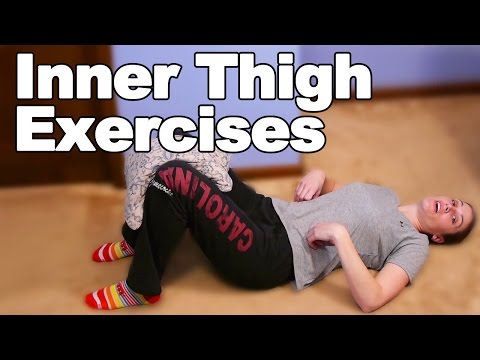
Inner Thigh Strengthening Exercises This inner thigh workout is great for strengthening your thigh muscles. For Doctor Jo’s blog post about this video, visit:
Related Videos:
Pulled Groin Stretches & Exercises:
Hip Flexor Stretches & Exercises:
===========================================
Click Below to SUBSCRIBE for More Videos:
=======================================
Doctor Jo is a licensed Physical Therapist and Doctor of Physical Therapy.
Facebook:
Twitter:
=======================================
More Details About This Video:
Our inner thigh muscles are made of our hip adductor muscles and our groin muscles. These simple exercises will show you how to strengthen these muscles. You can also see how to stretch these muscles in the groin stretches video.
First, using the resistive band, put one end in the door and close it tight. Wrap the band around either leg. You will do the exercises on both legs. The leg that has the band on it is working dynamically or with movement, and the other leg is working statically to keep you stable. You will keep your leg straight and try not to bend your knee. Pull your leg across your body into hip adduction. Next, you are going to lie down on your back with your knees propped up in a hooklying position. Take a thick pillow or ball and place it between your knees. Squeeze into the ball or pillow and hold for 3-5 seconds. Finally, you will lie on your side with the leg you want to work on the ground. Keep your body in a straight line, and bend your top leg in front of or behind the bottom leg. Keep the bottom leg straight and try not to bend your knee. Lift your leg off the ground only about 4-6 inches. Start with 10-15 and work your way up. If you have ankle weights, you can add those when it becomes easy.
Inner Thigh Strengthening Exercises
DISCLAIMER: This video and any related comments are not medical advice. Doctor Jo is a licensed Physical Therapist and Doctor of Physical Therapy; however, she is not YOUR Physical Therapist and can’t possibly diagnose you through the Internet. So don’t use this information to avoid going to your own healthcare professional or to replace the advice they have given you. This information is only intended to show you the correct technique for physical therapy exercises and should not be used to self-diagnose or self-treat any medical condition. If you are not properly diagnosed, this information won’t help, and it could make things worse. So seriously, check with your healthcare professional before doing these techniques. If you experience any pain or difficulty while doing these exercises, stop immediately and see your healthcare professional.




